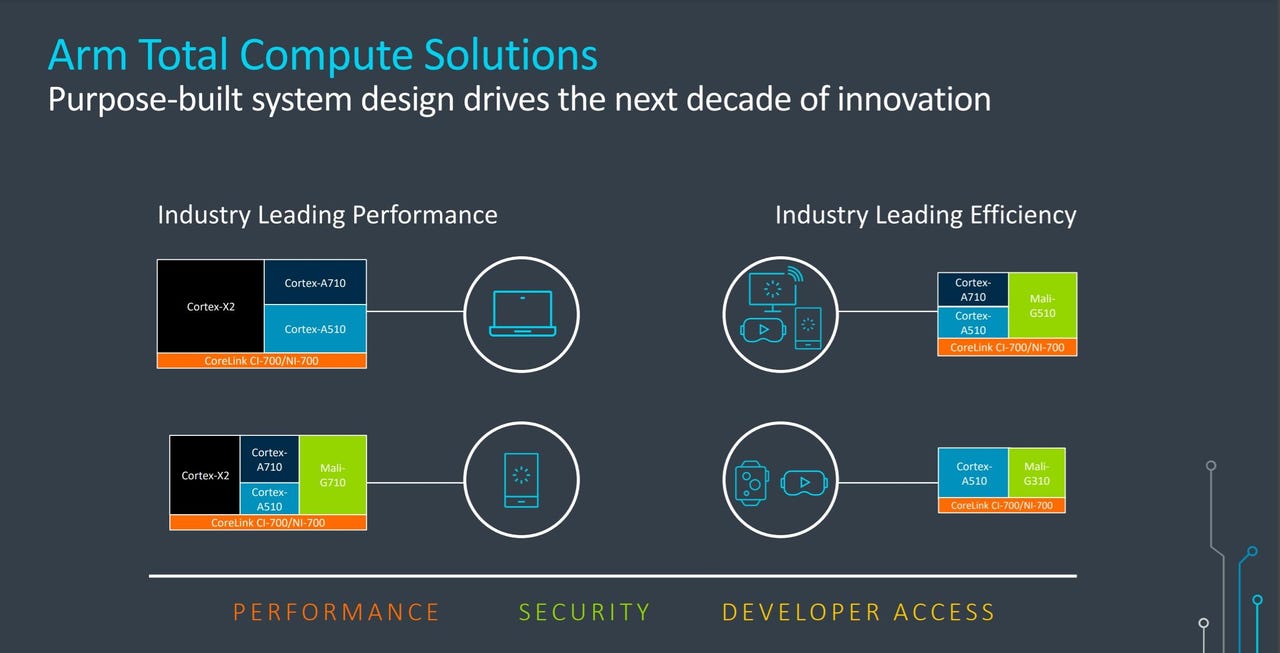Arm debuts new "Total Compute" suite of IP for smartphones and more

Arm on Tuesday launched its "Total Compute" solutions, a suite of IP with the flexibility to power a range of devices, from the very lowest-power wearables and smart home devices, all the way up to the highest-performance laptops. The new Armv9 architecture serves as the foundation for the Total Compute portfolio, which includes new Arm Cortex CPUs, Mali GPUs and new CoreLink Interconnect technology.
The new suite of IP "meets this trend of purpose-built compute that we're seeing -- people taking the smartphone SOC approach and using it for these different markets," Paul Williamson, SVP and GM of Arm's Client business, said to ZDNet.

Increasingly, the smartphone SOC is a mixture of a core CPU cluster, which handles major applications, coupled with dedicated accelerators for key tasks such as launching games. This sort of SOC allows devices to offer better battery life and performance in smaller, thinner form factors, and it allows for richer experiences in wearables.
The new offerings start with Arm's first Armv9 CPUs.
The Arm Cortex-X2 is Arm's most powerful CPU to date, delivering 30% performance improvements over current flagship Android smartphones. The Cortex-X2 is scalable across premium smartphones and laptops, allowing for purpose-built compute.
The Cortex-A710 is the first Armv9 "big" CPU, with a 30% energy efficiency gain and 10% uplift in performance compared to the Cortex-A78.
The Cortex-A510 is the first high-efficiency "little" core in four years, delivering 35% performance improvements and over 3x uplift in ML performance. Its performance nearly matches that of previous-generation "big" cores from a few years ago.
Arm is also introducing a new DynamIQ Shared Unit, the DSU-110, to serve as the backbone for a CPU cluster. It supports up to 8 Cortex-X2 CPUs, as well as security and ML features.
Arm is also introducing its widest range of GPUs to date, underscoring how ubiquitous visual experiences have become on digital devices. The Mali GPU is the world's top-shipping graphics processor, Arm says -- Mali GPU technology is already in about 80% of the world's smart TVs.
The new Mali-G710 is Arm's highest-performing GPU, targeting premium smartphones and the growing Chromebook market. It delivers 20% performance improvements for compute-intensive experiences, such as AAA high-fidelity gaming. It also offers a 35% machine learning uplift for a variety of ML-related tasks, such as image enhancement for the new camera and video modes.
The Mali-G610 is a new sub-premium GPU, which comes with all the features of the Mali-G710 but at a lower price point.
The Mali-G510 offers 100% performance improvements and 22% energy savings for longer battery life. It also offers 100% ML uplift for mid-range smartphones, premium smart TVs and set-top boxes.
The Mali-G310, featuring the Valhall architecture, delivers the highest performance at the smallest area cost. It's designed for devices like entry-level smartphones, AR devices and wearables.
Finally, Arm is introducing the new CoreLink CI-700 Coherent Interconnect and the CoreLink NI-700 Network-on-Chip Interconnect, delivering increased security as well as improved bandwidth and latency. They also offer hardware-level support for new Armv9-A features, such as Memory Tagging Extension (MTE).